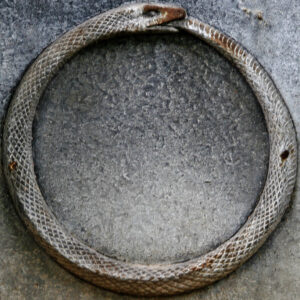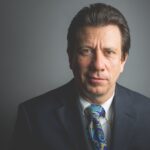Ouroboros: The Cycle of Renewal in Medical Education
FRASER SMITH, MATD, ND
Life is full of cycles of birth, growth, senescence, and death, only to start anew. As we study biology in medical school, we learn about cell cycles, biochemical cycles, and feedback loops that grow, self-extinguish, and then start up again. Medicine, and medical education, has also operated in cycles over time. This month, we look to the ancient symbol of ouroboros as we contemplate how medical education, and the naturopathic variety of it, works in a cyclical way.
The ouroboros symbol (Figure 1) is recognizable as “the snake eating its own tail.” Its origins stretch back across time and several continents, and with somewhat different meanings. We start in Africa, with the tomb of Tutankhamun, about 3300 years ago. At that time, the ouroboros symbolized immortality as well as the cycles of time, which moved with the seasons for people in that civilization and was conceived of as more circular than linear. Although the ouroboros didn’t originate in Greece, the term is Greek, and the Greeks associated the symbol with “infinity.”1 Norse mythology has examples of this symbol, as does Renaissance alchemy, with the connotations of immortality and the coexistence of humanity and divinity, and heaven and earth (not unlike Chinese medicine).1 Ancient India would use this symbol to denote destruction and creation squaring off, giving birth to life.2 Indigenous nations of North, Central, and South America used this symbol, as did ancient Persia.2 The ouroboros could almost be said to be universal.
Figure 1. Ouroboros

Cycles in Medicine
When we look at the history of medicine and medical education, we see cycles of construction and destruction. The medical knowledge and the technology used by medicine changes over time, but the way that physicians think about health, disease, therapy, and patients undergoes transformations. The arrival of the scientific method rapidly advanced knowledge about the human body that has informed our thinking; however, medicine remains a human activity, centered on human beings, as opposed to a solely technical procedure, such as etching a design into a silicon wafer or constructing a battery to power an automobile.
Harris Coulter was an historian and proponent of homeopathy. While I don’t agree with all of his positions on contemporary health care, Coulter’s work on the dichotomy of medicine in the western tradition is unparalleled. This is, of course, 1 strand among many strands of healing, medical systems (such as Ayurveda), indigenous medical systems, and more. In his works, Divided Legacy – a 4-volume series – Coulter traces the evolution of the Rationalist School and the dichotomy between it and what he termed the “Empirical School.”3 The “Rationalist” School was the forerunner to the biomedical (aka conventional medicine) model of health care that spans the globe.
The Empirical School – which includes Hippocrates, Hahnemann, Pasteur, and many others – put the highest value on observing clinical data from the particular patient they were examining. Generalizations about many patients had some value, but what was particular about a few had even more value, and the particular patient in this moment had the most.
Coulter writes:
The Empirical approach would be that the body is capable of responding creatively to any antigenic stress impinging upon it from the outside. … The evidence of this reaction is seen in the patient’s symptoms. Hence they have to be regarded as beneficial phenomena, as signs of reaction, signs of an effort by the body to cure itself.3
According to Coulter, this was a truly vitalist approach, in that the “creative reactions” to stress was most important, and physicians should therefore focus on supporting that adaptation and sometimes assisting it.
The Rationalist School, on the other hand, was interested in taking the same data from a patient but filtering out certain symptoms that corresponded to certain disease categories. This process led directly to the treatment at hand. The fact that the “disease” in question was often not related to the patient at this moment and was based on generalizations was not important. The clinical data were important because they helped to draw a line to 1 of several disease categories. While the patient’s suffering was real enough, the symptoms that could fit a definition lent themselves to a hypostatization, ie, taking an abstract notion and treating it like a thing in itself.3
Coulter continues:
So Rationalist physicians rejected the idea that the body is a reactive entity. Denying vitalism, they espoused a determinist and reductionist view of the body, seeing its material structure as determining its possible modes of behavior in sickness and health. In particular, they rejected the possibility that the body can react creatively to stress. They saw the patient’s body as a passive object, the recipient of insults from the external environment. In a way which was never actually explained, the external stress was seen as giving rise to an entity within the patient’s body which they called the disease “cause.” … Hence they thought it perfectly natural for the physician to eliminate or suppress these symptoms. They were much opposed to the Empirical “similar” remedy and instead used the concept of the “contrary” medicine, which nullified the symptoms and thus supposedly cured.3
A Tense Balance
This tension between approaches manifests in struggles between different movements, for instance, 19th-century homeopathy and the “old school,” which had medical doctors using the therapies of the time (bloodletting, mercury, and a few simple surgeries). Interestingly, Coulter reveals that this tension is within all medical professions and movements. It is within conventional medicine, and within chiropractic, homeopathy, and naturopathic medicine.
Coulter gives examples through history, and it would be interesting to extend his work to examine other traditions and other systems. The cycle that Coulter describes, starting over 2500 years ago and repeating every few generations, typically has the Rationalist School on the ascent.
As a more rationalist mode of thought, and then training, and then practice, takes hold across a generation or 2, treatments become more standardized. Practitioners of more modest talent might do better economically because they can see far more patients in a day by doing routine therapies. But what usually happens? Things slow down, so to speak. Therapeutic results become lackluster. Physicians get frustrated as new diseases seem to emerge. The old diseases, which were more easily suppressed with the drugs they learned about in their training, were far easier to handle. New types of reactions from patients don’t yield themselves to the “owner’s manual” that came with their practice. Some of the brighter doctors trained in this method suspect there is something about the old model of practice that is not lining up with reality; however, not wanting to self-terminate their career by being cast out of the local medical guild or county medical society, they play along.
At that moment, a strong dose of Empirical medicine, from within or without their profession, shakes things up. New treatments and ways of thinking emerge. These arise out of direct observation of patients and the effects of medicines on them, as well as the application of these lessons not to all patients but rather to like situations on a very small scale. You could say that physicians start to again observe the patient carefully and to use medicines they know will assist the patient in their own healing reaction, while also looking for ways to remove health-destroying factors such as poor nutrition or missing ingredients of health. Suddenly, the medical enterprise feels reinvigorated. Some cures remain elusive, but the tools of the trade seem right for the cases presenting to clinic.
Over time, it can become difficult to maintain a level of properly executed Empirical medicine. It’s not a cookbook. Patients and their milieu change, so the case histories the professors taught their students don’t quite ring as true as they once did. Some of the doctors maintain their Empirical approach because they have mastered its principles and stay abreast of patient issues. Others begin to look for a “method” that is more reproducible. They look for a faster, streamlined way. The apparent successes of some approaches become abstracted and are taught out of context. A new swing to the Rationalist approach begins. And, thus, the cycle repeats itself. Ouroboros.
Lust’s Time
The founding of Naturopathy was a kind of countermeasure to a prevailing Rationalist approach that was the dominant mode of medicine in the United States and similar countries. Drawing on deep European roots of water cure and herbalism, Naturopathy incorporated new practices. Although many traditional practices (including the strong African American healing tradition) and Indigenous medical practices never lost their Empirical orientation, North American health care, in general, was very Rationalist. Naturopathy, Eclecticism, Thomsonianism, homeopathy, and chiropractic all sought to redress this.
Lust had a very solid idea about healing. This was expressed as removing the causes of disease and the habits of living that engendered them, teaching new modes of living, and using gentle therapies that worked with the reactive force of the body.
Lust wrote at one point:
Since the earliest ages, Medical Science has been of all sciences the most unscientific. Its professors, with few exceptions, have sought to cure disease by the magic of pills and potions and poisons that attacked the ailment with the idea of suppressing the symptoms instead of attacking the real cause of the ailment.4
Lust described much of the thinking that seemed to lock people compulsively, almost fervently, into this type of treatment as a kind of superstition. Not surprisingly, even in its nascent, hydrotherapy-centered form, the early naturopaths and Kneipp society healers, including Lust, were virulently attacked by the Medical Societies.5
Impact on Education
Naturopathic medical training, especially since the retooled version of it (and the one everyone reading this article has been trained in), has had to evolve to draw on both branches of medical thought. Brilliant people, like Dr John Bastyr, fused medical diagnosis with patient-specific thinking as a guide to therapy. In some sense, it was inevitable that naturopathic medical education would develop more of a footing in a disease-based – hence Rationalistic – model. The precise description of the mechanisms of disease – at the biochemical, cellular, proteomic, and genomic levels – are vastly more comprehensive now than in the past. What might have been a hastily generalized notion about a disease in the practice of an old-school medical doctor of the 1850s is now more of an acknowledgement of facts in a biopsy- or imaging-guided diagnosis of 2021. Therapies such as antibiotics or emergency-medicine drugs work as promised and do great good.
At the same time, the Empirical School lives on in naturopathic medicine. As a counterpoint to a much larger standard medical system, our medicine reserves the right to consider important facts about specific patients, even if they are more than 2 standard deviations from the norm. Our training, then, has to comprise both an understanding of the biomedical approach and the ability to simultaneously evaluate the function or dysfunction in a particular patient in a given moment. It is not easy to do this. The clarity and certitude, and obviously deep information, behind a biomedical approach have the gravity to pull any curriculum in a naturopathic program into it. To maintain an educational grounding in the Empirical School, a naturopathic curriculum must offer contiguous courses, over an extended period of time, which start with clinical theory, then move to an explanation of how this theory is applied to cases, and then finally put it into action under mentorship with actual patients. That’s far more than a cursory look at a friendly philosophy.
Coulter showed us that professions tend to align with either polarity but that both polarities exist within a profession. Perhaps this is a fruitful dynamic. A more Rationalist approach in our training of future naturopathic doctors helps present the material in an evidence-based perspective. Students need a starting point from which to build, and a linear approach lends itself well to that.
But naturopathic medical education has to be so much more. We assumed the mantle of the Empirical approach by our very existence. To allow the gravitational pull of that stark Rationalist approach to overshadow the patient-centered, vitalistic approach that seeks to understand the individual patient’s reactions to stressors and disturbed determinants of health as the important event is to lose ourselves. The world needs medical doctors, osteopathic doctors, nurse practitioners, and physician assistants who work the medical model. And it desperately needs physicians who have stock in the Vis Medicatrix Naturae. The only way that these Empirical School physicians will continue to appear is if we intentionally and effectively educate them to this end.
Having achieved a level of expertise in training talented students to be primary-care doctors over 4 calendar years, it is clear that we’ve come very far in developing a physician level of training in our colleges. If we find that the expansion of naturopathic medical education is losing momentum, that we are questioning our raison d’etre, we ought to reexamine our rootedness in the Empirical approach. If it seems like other professions are popularizing therapies that we’ve used much longer (keeping in mind that we all borrow from each other), the problem is not the medical doctors lifting our therapies. Rather, it may be our declining ability to use them in a way that’s informed by inductive reasoning based on a close observation of the patient’s symptoms and reactions. If that’s a hill we find ourselves sliding down, then a re-birth of sorts in naturopathic medical education is timely.
References:
- Bekhrad J. The ancient symbol that spanned millennia. December 4, 2017. BBC Web site. https://www.bbc.com/culture/article/20171204-the-ancient-symbol-that-spanned-millennia. Accessed July 23, 2021.
- Ancient Pages. Ouroboros: Ancient Infinity Symbol Used by Different Ancient Civilizations. Available at: https://www.ancientpages.com/2017/10/03/ouroboros-ancient-infinity-symbol-used-by-different-ancient-civilizations/. Accessed July 23, 2021.
- Coulter HL. Empiricism vs. Rationalism in Medicine. The Journal of Orthomolecular Medicine. 1994;9(3). Available at: http://orthomolecular.org/library/jom/1994/articles/1994-v09n03-p159.shtml. Accessed July 23, 2021.
- Cody GW, Hascall H. Chapter 4: The History of Naturopathic Medicine. In: Pizzorno J, Murray M, eds. A Textbook of Natural Medicine. St Louis, MO: Elsevier; 2015. Available at: https://clinicalgate.com/the-history-of-naturopathic-medicine-the-emergence-and-evolution-of-an-american-school-of-healing/. Accessed July 23, 2021.
- Czeranko S. Past Pearls, the Trials of Benedict Lust. NDNR. 2010;6(11). Available at: https://ndnr.com/education-web-articles/past-pearls-the-trials-of-benedict-lust/. Accessed July 23, 2021

Fraser Smith, MATD, ND is Assistant Dean of Naturopathic Medicine and Professor at the National University of Health Sciences (NUHS) in Lombard, IL. Prior to working at NUHS, he served as Dean of Naturopathic Medicine at the Canadian College of Naturopathic Medicine (CCNM) in Toronto, Ontario. Dr. Smith is a licensed naturopathic physician and graduate of CCNM.









